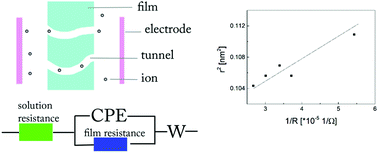Correlation between the ion permeation and free volume property in ethyl cellulose film during the acid treatment†
Abstract
Ethyl cellulose can be applied as an erasable barrier coating. The microstructure of this coating is a key factor that influences the anti-corrosion property. To investigate the correlation between the hole structure and the acid treatment time, the microstructure of the ethyl cellulose immersed in acid for different times was evaluated. Scanning electron microscopy (SEM) showed that holes enlarged by around 100 nm in the samples immersed for longer time. Electrochemical impedance spectroscopy (EIS) implied that the film resistance decreased, while the positron annihilation lifetime measurement indicated that the free-volume holes enlarged with the increase in the immersing time. All the results were in agreement with each other. A model has been proposed to explain the film resistance, where the film resistance was inversely proportional to the cross-sectional area of pores for ion permeation. The experimental data confirmed that free-volume holes acted as the tunnels for the ions permeating through the EC film. This could be a potential method to evaluate the tortuosity of holes in membranes by coupling the membrane resistance with free-volume hole size.



 Please wait while we load your content...
Please wait while we load your content...